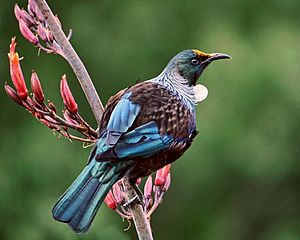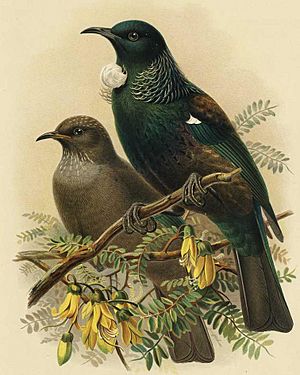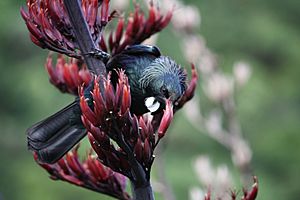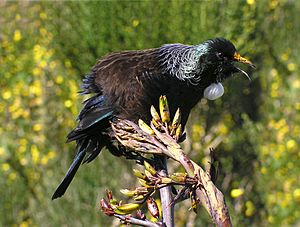Tui (bird) facts for kids
Quick facts for kids Tui |
|
|---|---|
 |
|
| Tui on a flax flower stalk, with pollen on its head | |
| Conservation status | |
| Scientific classification | |
| Genus: |
Prosthemadera
|
| Species: |
novaeseelandiae
|
The tui (Māori: tūī; Prosthemadera novaeseelandiae) is a lively bird that lives only in New Zealand. It has beautiful blue, green, and bronze feathers. A special white fluffy tuft on its throat makes it easy to spot.
Tui are the only bird in their group, called Prosthemadera. They are one of the biggest honeyeater birds. Honeyeaters are a family of birds known for eating nectar. You can find tui all over New Zealand, from warm islands in the north to colder ones in the south.
Contents
The Tui's Name
The name 'tui' comes from the Māori language. When you talk about more than one tui, you just say 'tui'. It's like saying 'sheep' for one or many.
Long ago, European settlers called them 'parson birds'. This was because their white throat tuft looked like a parson's collar. They were also called 'mockingbirds' because of their many different sounds. But these old names are not used anymore.
What Does a Tui Look Like?
The tui is a large honeyeater, usually about 27 to 32 centimeters (11 to 13 inches) long. Tui from the Chatham Islands are often bigger and heavier. Male tui are usually heavier than females.
At first glance, a tui might look completely black. But if you look closely, you will see it has brown feathers on its back and sides. Its feathers also have a shiny, rainbow-like look. This shimmer changes color depending on how the light hits it. Tui also have tiny, white, lace-like feathers around their neck. This makes them look very fancy!
Where Tui Live
Tui are found in many parts of New Zealand. They live on the North Island and the west and south coasts of the South Island. You can also find them on Stewart Island and the Chatham Islands. There is a special kind of tui on the Chatham Islands that is in danger.
Other tui groups live on Raoul Island and the Auckland Islands. Tui populations have gone down since people from Europe settled in New Zealand. This is mainly because their homes were destroyed. Also, new animals brought to New Zealand, like possums and cats, hunt tui.
Even with these challenges, tui are doing better in some areas. This is often where people have removed farm animals, allowing plants to grow back. Animals like brushtail possums, cats, stoats, and rats still pose a threat. They can eat tui eggs and chicks.
Tui like to live in forests with broadleaf trees, especially at lower elevations. But they can also live in small patches of forest, new plant growth, or even well-planted suburbs. They are one of the most common birds in the city of Wellington. Tui are usually seen alone, in pairs, or in small family groups. However, many tui will gather together where there is a lot of food. They often join other birds like silvereyes, bellbirds, or kererū (New Zealand wood pigeons).
When tui and bellbirds compete for food, tui are usually in charge. Tui will often chase bellbirds away from good food sources, like a flowering flax plant.
Tui Behavior and Life
Male tui can be very protective of their space. They often chase other birds away from their territory. They do this with loud wing flaps and sounds that can seem like rude human speech! This is especially true if another tui tries to share their favorite feeding tree. Tui will fluff up their feathers to look bigger and scare off rivals. They have even been seen chasing away larger birds like harriers and magpies.
Tui have short, wide wings. This helps them fly very well in thick forests. But it also means their flight is quite loud because they flap their wings very fast. During the breeding season in spring (September and October), you might see a male tui's special mating flight. They fly straight up very fast, then stop and dive down, repeating the move. Only female tui build nests. They make them from twigs, grasses, and moss.
What Tui Eat
Tui mainly drink nectar from flowers. But they also eat fruit and insects often. Sometimes they eat pollen and seeds too. They especially love the nectar from New Zealand flax plants. This nectar can sometimes ferment, which means it turns a bit like alcohol. When tui drink this fermented nectar, they can fly in a way that looks like they are a little bit drunk!
Tui are very important for many New Zealand plants. They are the main pollinators for flax, kowhai, and kaka beak flowers. These flowers are shaped perfectly for the tui's beak. This is a great example of how plants and animals help each other grow and change over time.
Tui Songs and Calls
Tui have many different songs and calls, much like parrots. They can even learn to copy human speech clearly! Māori people used to train tui to repeat complex words.
Tui are also known for their loud and unusual calls. Each tui has its own unique sound. Their calls can mix bell-like notes with clicks, cackles, creaks, groans, and wheezing sounds. Birds like the tui have a special organ called a syrinx. This helps them make very complex sounds. Tui songs also change depending on where they live, the season, their gender, and even their individual personality.
Some of the sounds tui make are too high or too low for humans to hear. When a tui sings, you might see its beak open and its throat tufts moving, even when you don't hear a sound. Tui will also sing at night, especially when the moon is full.
See also
 In Spanish: Mielero tui para niños
In Spanish: Mielero tui para niños





